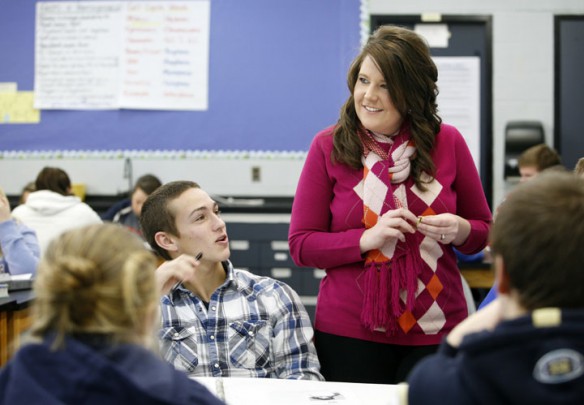
Holly Wood checks over the note-taking of sophomores Bailey Spalding and Nicole Mattingly in her Pre-AP Biology class at Marion County High School. The students were using the New American note-taking method while reading about genetic engineering. Photo by Amy Wallot, Jan. 4, 2012
By Susan Riddell
Holly Wood, a biology teacher at Marion County High School, joined the Science Leadership Support Network (SLSN) in 2006 because she felt it would help her grow as a teacher.
“Being a young teacher and rolling out Core Content 4.1, my district found it important to send someone,” Wood said. “I had a great experience, but as budget stories go, I was unable to attend the next few years.”
Last year, however, she got an e-mail from Kim Zeidler, director of the P-12 Mathematics and Science Outreach for the Partnership Institute for Mathematics and Science Education Reform (PIMSER). The e-mail was informing science teachers about a grant helping teachers implement the new standards.
“I wanted to make sure I got a chance to be a part of this group,” Wood said. “SLSN has provided me with the opportunity to experience the changes taking place in science education first-hand while providing instructional strategies and collaboration with other quality science teachers from across the state.”
Science teachers are waiting for the new science content standards to be released later this year. In the meantime, they have been hard at work integrating content literacy standards for reading and writing standards in the Kentucky Core Academic Standards (KCAS) for English/language arts (ELA).
Zeidler said the SLSN had put a lot of time into informational texts and other sources, but argumentative writing is now a primary concern regarding the literacy science standards.
But the SLSN isn’t alone. The Preparing All Students for Success (PASS) group, funded by the Council on Postsecondary Education, has been working for more than a year along with the SLSN to make meaning of the literacy standards in science for reading and writing and to integrate them into their instruction.
Mike Epperson is in his 16th year at Murray Middle School (Murray Independent). He has taught science the past 15 years and started working with the PASS program in 2010. He attends monthly meetings targeting the standards.
“The goal is to increase student achievement and help our students reach the next level whether it is for college prep or being scientifically literate adults in society.
“(The literacy standards) help teachers shape the way of learning and thinking like scientists,” Epperson added. “They are another tool to use to get a great depth of thinking and learning.”
Zeidler said teachers have made progress in coming up with high-quality lessons regarding the literacy standards, in particular the lessons dealing with argumentative writing.
“In working with the teacher leaders, we’ve been discussing how argumentative writing is different from persuasive writing,” Zeidler said. “In implementing the standards, students make a claim and support it with valid reasoning and relevant and sufficient evidence from the text to create a viable argument.”
Epperson said there is a clear difference in argumentative and persuasive writings.
“Persuasive pieces tend to persuade someone to do something such as take action or believe the way I do with emotional appeal,” he said. “Argumentative pieces use evidence and/or data to establish why this particular point of view is correct. It’s more about truth and not taking sides.”

Holly Wood listens to sophomore Anthony Hagan share his views on genetic engineering during her Pre-AP Biology class at Hardin County High School Jan. 4, 2012. Students were reading articles about the subject and writing a piece on their views using an argumentative frame. Photo by Amy Wallot
“An argumentative piece requires explanation of why a claim is what it is,” Wood added. “Students have to actually evaluate what they are saying in light of the data. Persuasive pieces, especially in the old portfolio requirements, tended to be a forced fit. Argumentative isn’t that way: it lends itself to science.”
Being skeptical as a scientist complements argumentative reasoning well, according to Wood.
“We, as scientists, have to look at all of the possibilities and then, based on the data, we come to a decision, and we support that decision using evidence,” Wood said. “When students can take the information in front of them, make sense of the information from different viewpoints, decide what they believe to be true, but most importantly back up their hypothesis with the data, they begin to understand what it is like to be a lifelong learner.
“If science teachers don’t find themselves constantly asking ‘Why?’ in their classrooms, I would dare say their students are not experiencing those higher levels of thinking that is imperative for students to be college- and career-ready after high school.”
Zeidler said that Kentucky is involved in a partnership with the Literacy Design Collaborative (LDC), and they offer resources to help teachers effectively implement the standards into daily instruction.
“We are using the materials from the LDC to support the science teachers and will be sharing their LCD teaching tasks and student work with other teachers in our state through the Continuous Instructional Improvement Technology System (CIITS) and our PIMSER website,” Zeidler said.
Both Wood and Epperson agreed that all teachers need to embrace the changes the literacy standards for science bring.
“Jump on board or jump ship. At least that’s what I’d like to say,” Wood said. “The standards are different. There are things we enjoy teaching that are no longer considered core and there is other content that we have never taught that is going to be required.
“All school districts are experiencing end-of-course assessments for the first time,” Wood added. “We have all been Classroom Assessment for Student Learning- (CASL) trained. We are all more assessment literate than we ever thought possible. We are leaders by nature, and it is difficult for us to loosen the reins and allow students to manipulate their own learning. I would suggest embracing the new standards and instructional strategies one at a time. Implement something that isn’t so drastic, something a teacher can do comfortably. We are running a marathon, not sprinting, so pace yourself.”
Epperson believes science teachers will come to embrace the new standards.
“Once science teachers get the information, training and practice, they’ll see that this will bring about a greater depth of learning and teach our students to really think like scientists,” Epperson said.
MORE INFO …
Kim Zeidler, Kim.Zeidler@uky.edu, (859) 257-4836
Mike Epperson, mike.epperson@murray.kyschools.us, (270) 753-5125
Holly Wood, holly.wood@marion.kyschools.us, (270) 692-6066




Leave A Comment